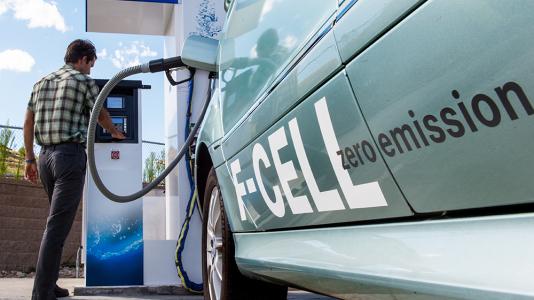
Fuel cells, when coupled with hydrogen, are clean, reliable, and efficient energy sources. Water is the only by-product. They work like batteries, but do not need recharging if there is a constant source of fuel and oxygen. Fuel cells can power everything from cars to buildings.
However, cost and durability are challenges. A chief cost driver is platinum, an expensive metal used in the catalyst needed for polymer electrolyte fuel cells (PEFC). Iridium and platinum are also needed for the electrolyzers that extract hydrogen from water. For example, platinum accounts for more than 40% of the cost of an automotive PEFC, the type of technology used in some hydrogen fuel cell vehicles. Replacing platinum with catalysts containing Earth-abundant elements such as iron, carbon, and nitrogen could cut costs.
To that end, the U.S. Department of Energy’s (DOE) Argonne National Laboratory is co-leading the ElectroCat consortium. The initiative was created in 2016 with the goal of deploying such Earth-abundant, platinum-free materials for catalysts used in fuel cells. ElectroCat was expanded in 2020 to include iridium-free and platinum-free catalysts for water electrolyzers.
“The ultimate goal of ElectroCat is to replace all platinum group metal catalysts in polymer electrolyte fuel cells and anion-exchange membrane electrolyzers without sacrificing performance or durability,” said Deborah Myers, an Argonne senior chemist, group leader, and co-lead of the ElectroCat consortium.
Researchers are working in Argonne’s High-Throughput Research Laboratory to synthesize and test potential catalyst materials at a rapid pace. Argonne is focusing on high-throughput synthesis and evaluation, multi-scale modeling, and characterization methods. Scientists are using X-ray techniques at Argonne’s Advanced Photon Source to provide a better understanding of catalyst structure and degradation mechanisms to help developers increase durability and performance of these Earth-abundant materials.
“We are able to characterize the atomic structure of the catalysts during fuel cell operation using unique hardware developed by Argonne to understand how these catalysts work and why they degrade,” Myers said.
Argonne is making great strides in developing PGM-free fuel cell technology, improving both the performance and durability. ElectroCat researchers have also developed test protocols for quickly assessing the viability of PEFCs, published recently in Nature Catalysis.
When fuel cells are fully deployed into commercial markets, the technology will play a critical role in reducing the greenhouse gas emissions driving the climate change crisis, Myers said.
ElectroCat is part of the DOE-Energy Efficiency and Renewable Energy’s Energy Materials Network. Los Alamos National Laboratory is co-lead on the ElectroCat initiative.
This article is part of Argonne’s ongoing “Hydrogen Highlights” series.